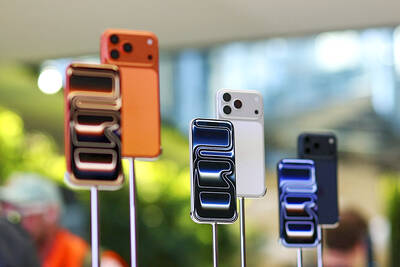E Ink Holdings Inc (元太科技), which supplies e-paper displays for Amazon.com Inc’s Kindle e-reader series, swung into profit ability last quarter, as major customers launched new-generation products and boosted business in emerging markets, a senior executive said yesterday.
The Hsinchu-based company posted NT$511 million (US$17.23 million) in net profit, or earnings per share (EPS) of NT$0.45, compared with net losses of NT$1.01 billion, or NT$1.39 in losses per share, in the preceding quarter, company data showed.
During the July-to-September period, the company's gross margin rose to 21.8 percent from 7.1 percent the previous quarter.
The company still incurred a loss of NT$228 million last quarter on an operating basis, but its non-operating operations posted NT$459 million in profit to help the company turn profitable.
Last quarter's results ended two straight quarters of net losses and E Ink is expecting quarter-on-quarter business growth this quarter, although the company's sales slid 8.56 percent last month to NT$2.03 billion, from September because of labor shortage in China, chief financial officer Eddie Chen (陳彥松) told an investors’ conference in Taipei.
“We need to hire 1,000 more workers to meet demand for the coming months,” Chen said.
He said customers are confident about the growing popularity of e-readers ahead of the Christmas season, as a survey by the US Pew Research Center showed an increase in e-reader penetration from 19 percent to 24 percent this year, with the trend likely to spread to other parts of the globe.
Customers have strengthened deployment outside North America in such markets as China, Japan, the Philippines, Italy, India and Ireland, he said.
Flexible applications, including smart watches, bag tags and view tags, will be another highlight, with Japan’s Sony Corp set to launch the world’s lightest digital e-paper device yet on Dec. 3, Chen said.
E Ink is also seeking to tap into business opportunities linked to mobile devices, as some use the devices simply to read e-mail and may switch to handsets featuring the company’s e-paper, Chen said.
“All we aim for is 1 percent of the vast segment,” he said, acknowledging that e-paper devices do not offer the interactive experiences that attract most mobile users.
During the July-to-September period, E Ink’s gross margin jumped to 21.8 percent, from 7.1 percent three months earlier, company statistics indicated.
Shares in E Ink closed down 1.79 percent to NT$13.7 yesterday on the Gretai Securities Market.
This story has been updated since first published.

Taiwan’s rapidly aging population is fueling a sharp increase in homes occupied solely by elderly people, a trend that is reshaping the nation’s housing market and social fabric, real-estate brokers said yesterday. About 850,000 residences were occupied by elderly people in the first quarter, including 655,000 that housed only one resident, the Ministry of the Interior said. The figures have nearly doubled from a decade earlier, Great Home Realty Co (大家房屋) said, as people aged 65 and older now make up 20.8 percent of the population. “The so-called silver tsunami represents more than just a demographic shift — it could fundamentally redefine the

The US government on Wednesday sanctioned more than two dozen companies in China, Turkey and the United Arab Emirates, including offshoots of a US chip firm, accusing the businesses of providing illicit support to Iran’s military or proxies. The US Department of Commerce included two subsidiaries of US-based chip distributor Arrow Electronics Inc (艾睿電子) on its so-called entity list published on the federal register for facilitating purchases by Iran’s proxies of US tech. Arrow spokesman John Hourigan said that the subsidiaries have been operating in full compliance with US export control regulations and his company is discussing with the US Bureau of

Businesses across the global semiconductor supply chain are bracing themselves for disruptions from an escalating trade war, after China imposed curbs on rare earth mineral exports and the US responded with additional tariffs and restrictions on software sales to the Asian nation. China’s restrictions, the most targeted move yet to limit supplies of rare earth materials, represent the first major attempt by Beijing to exercise long-arm jurisdiction over foreign companies to target the semiconductor industry, threatening to stall the chips powering the artificial intelligence (AI) boom. They prompted US President Donald Trump on Friday to announce that he would impose an additional

Pegatron Corp (和碩), a key assembler of Apple Inc’s iPhones, on Thursday reported a 12.3 percent year-on-year decline in revenue for last quarter to NT$257.86 billion (US$8.44 billion), but it expects revenue to improve in the second half on traditional holiday demand. The fourth quarter is usually the peak season for its communications products, a company official said on condition of anonymity. As Apple released its new iPhone 17 series early last month, sales in the communications segment rose sequentially last month, the official said. Shipments to Apple have been stable and in line with earlier expectations, they said. Pegatron shipped 2.4 million notebook